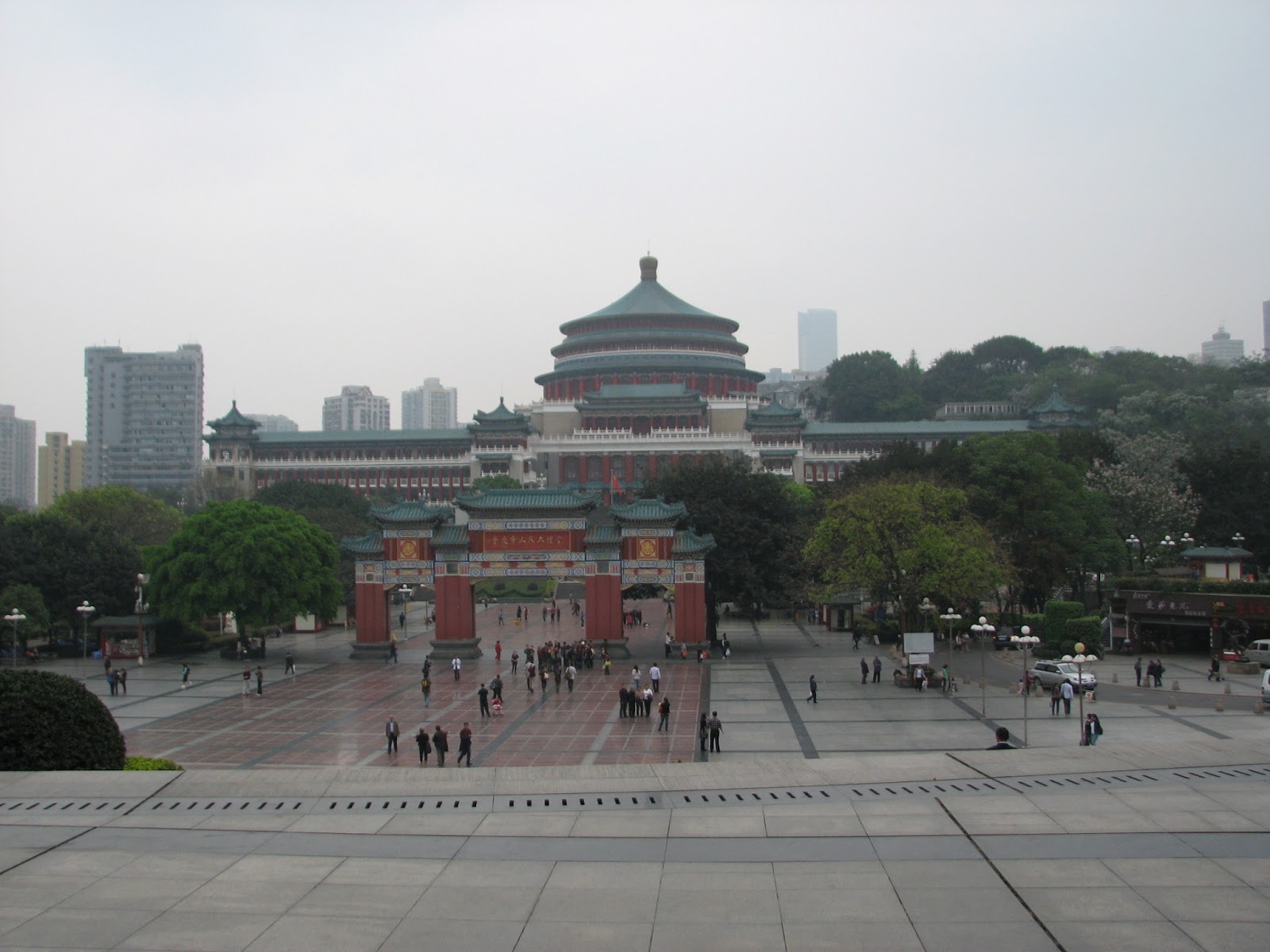We took the high speed railroad from Chengdu and in 2-1/2 hours, we were in Chongqing. The countryside along the way always interests me.
See the pagoda on the hill?
 |
| That's 121 miles per hour! Wheee! |
This could be somewhere in Europe with the green hills and cultivated fields.
We went downtown to the Great Hall of China, the first building constructed under the new government when The People's Republic of China was formed. It looks similar to the Temple of Heaven we visited in Beijing.
It's just a big convention-type center inside, so we didn't go in. We did go into the Three Gorges Dam Museum across the plaza. The museum is to educate the people on all the reasons the dam project was a good idea, and how willingly the 1.3 million people relocated when their homes and lifestyles were flooded underneath the water. (Tongue in cheek.)
We drove through the city, admiring the buildings, bridges, trains, highways, and other views from this mountainous area.
 |
| What a network of traffic, trains and people! |
We visited the General Joseph Stilwell Museum (his former residence and command center for the war against the Japanese - WWII). We were quite interested in this, as Kirk's father worked on building the Burma airstrip and once flew to China on a fuel run.
Stilwell was Chief of Staff under Chiang Kai-shek in what the Chinese call the World War against Fascism.
 |
| Jeanette would love this typewriter for her collection! |
This motorcycle looks like something Harold would have ridden (Kirk's Dad).
The "Hump Flight Route" over the Himalayan Mountains went from the airstrip in Burma, that Harold helped build, to Chongqing. It was a pretty dangerous mission, but crucial to the war effort.
 | |
| One of the jeeps of Merrill's Marauder's, part of the anti-Japanese offensive. |
The Flying Tigers, under General Claire Chennault, destroyed more than 2600 Japanese aircraft and sank 44 warships.
 |
| Part of the Burma Road |
The James Doolittle team led the bombing of Tokyo in 1942.
 |
| That looks like a pretty good use of an elephant! |
 |
| How much does that gorgeous embroidery cost? |
I succumbed to the beauty and bought one of these paintings on a banyan leaf. Mine is a beautiful Chinese woman with a scroll.
We drove to the ancient town section of Chongqing called Ciqikou. It's a major tourist area, and we weren't interested in shopping, so we went down to the river. Along the way, we met a couple of students who offered to show us the way. They stopped to buy some fish (a huge bag full) to release into the river.
We were surprised to see many people with beach umbrellas along the riverside. They weren't really swimming there, but seemed to be enjoying the day.
Our friend, a Buddhist, stopped to pray here at the site in the edge of the cliff overlooking the river. Then we went down to the river's edge and he held a turtle and prayed, reciting the names of all the Buddhas. When he finished, he released the turtle into the water. Then he emptied the bag of fish he just bought. He believes that because he recited the names of the Buddhas and released these formerly captive animals, they will be able to return as a human in their next life.
 |
| Maybe these are actually eels--I didn't look close. |
We walked back through Ciqikou and saw some interesting sights and shops.
 |
| The old and the new on the river. |
 | |
| Village Gate of Wenchang Palace |
This little hen and her egg box were on the side of the path. Had to take this photo to show the Merrills.
I had to take a photo of the sculpture. This is how they toilet train in China. The mother sings a little song while the child "does its job" and they are trained to respond to this song. The children wear split pants, as I've shown before, and it seems to work really well for them. You will often see this "pose" by real people when traveling in China.
Duck for dinner!
 |
| Me, Linda, Debbi and Karolee playing Mahjong in 20 years. |
 |
| Kirk won't play Mahjong when he's old, nor will he have enough hair to make the knot you see on the left. |
 |
| The local Buddhist Temple gate |
 |
| Fortune tellers - love the white beard! |
They have the cutest way of doing cotton candy. They use different colors of candy floss and create flowers and other delights. See the pink, yellow and white? Good idea!
 |
| Wenchang Palace from below. |
We drove back downtown to the center of the business district where we had a really great dinner and enjoyed being with our BYU Teacher friends again. So much to catch up on together!
This sign was on a pillar beneath a bridge--no firecrackers! Only in China!
 |
| This translation is funny--they meant to say foreigners can learn to cook Chinese food here. |
Downtown Chongqing. Our tour guide said he has never seen the top of that skyscraper because it's usually fogged over. The nickname for Chongqing is "Fog City". In the summer it can be 116 degrees with 94% humidity. Glad it was nice when we were there!
We drove down to the Yangtze River to board our cruise. Oh boy! The buildings had wonderful light patterns on them and it was all so festive and fun. Can't wait to set sail!
Our ship, the Victoria Selina, is on the left. We had to hike down the bank to it, as the water level is low this time of year in preparation for the spring run-off.
Next blog: Cruising the Yangtze River











































No comments:
Post a Comment